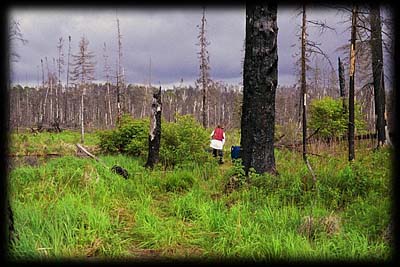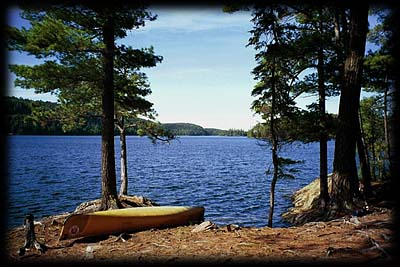The winding
creek continued on for an unmeasurable distance thanks the many
switchbacks and turns. After what seemed to be a couple of hours
of under-deadfall acrobatics and occasional wading in suckmud, we
reached the entry into the Wawiag River. Unfortunately, an enormous
tree had fallen and blocked access to the river, and a tiny portage
around it served as a warm-up for more to come.
Now on the Wawiag,
I remembered the gigantic logjams that we had seen from the air.
It was not long before we were able to see close-up the first of
these and made a short portage through an area burned by the fire
of 1995. The next portage bypassed a set of rapids, followed by
one around the final logjam.
We had been
worried that we would not make it to Kawa Bay by nightfall and as
sunset approached, we were most relieved to finally reach the bay.
Several islands about a mile distant beckoned, but with the light
waning, rather than risk discovering an occupied campsite, we selected
a site on the mouth of the Wawiag.
Four short portages,
various creek gyrations, and approximately thirteen miles of paddling
may not seem like much to the seasoned wilderness crew. To us however,
with our full load and it being the first day at this level of effort,
it was an extraordinary feat of endurance. We prepared a hurried
supper and exhausted, went immediately to bed and slept, I think
without moving, until morning.
As I opened
my eyes in the morning, I remained motionless and began taking in
the smell and sounds of the wilderness. I listened to the frequent
splash of fish jumping near the shore, the sounds of birds calling,
the sound of the water lapping the shoreline and the distant purr
of water cascading from an unseen creek or rivulet. I recall being
astonished when I thought of how we had gone from one of the most
densely populated areas on the planet to being deep in the wilderness,
in an almost legendary fishing lake.
I laid in my
sleeping bag wondering what the prior days' journey had done to
me physically. I slowly began moving, testing my muscles and back,
fully expecting to be partially paralyzed and in severe discomfort.
To my surprise, while I was a bit stiff, and I later gobbled a handful
of Motrins with breakfast, I was not as crippled and sore as I had
expected.
A beautiful
morning greeted us with favorable winds for the journey west along
Kawnipi. We were eager to begin fishing and I gave assurances to
Nathan that the previous day was the toughest that we would experience.
Our plans called for no portages and were simply going to fish our
way up the length of Kawnipi until we found a campsite of our liking.
As we began
trolling up Kawa bay, it soon became apparent that our progress
would be slow, as we were stopping every few minutes with the catch
of either a sizable Northern or Walleye. Kawnipi was certainly living
up to its reputation as a great fishing lake.
We headed up
the main expanse of the lake to the west and pitched camp early
on a nice site opposite Rose Island. We prepared a Walleye lunch
and snoozed away the warm afternoon, looking forward to more fishing
in the evening. 
As dusk approached,
our fishing was cut short by an approaching storm. We heard thunder
and hightailed it to camp to batten down for what was to be an exciting
evening. Rain began at dark, followed by lightening, thunder, and
strong winds. Our camp was fairly well protected from the wind by
the shape of the island, but we were still concerned about the ability
of the tent and surrounding trees to withstand the intense gusts.
Additionally, while I had tied down the canoe, I had not expected
my tie down to have to hold up to the seemingly almost hurricane
force winds.
I decided that
I had to risk going out into the rain, to lay another line on the
canoe to make sure that it didn't sail around like a kite on a string.
I could see quite well as the ground was illuminated continuously
by flashes of lightening reflected off the cloud layer. I made quick
work of this task and scampered back to the tent and a sense of
cover.
Next